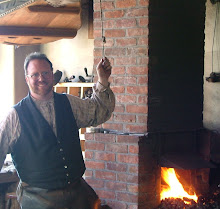Our research project to make a pistol in the style of the 1740 Pitcarn Pistol has continued through the summer of 2010. During the first year of summer Saturdays the team rediscovered how to make the hollow steel stock. The second year they forged, welded, and reamed the barrel. The third year they made the intricate parts of the lock mechanism. Finally, in the fourth summer of the project, they have been fitting, assembling, and engraving the components. Here are two pistols that have been filed smooth and white but are not yet engraved.
They are still a work in progress. The engraving is done by hand in the blacksmith shop using a chasing hammer to strike a tiny chisel called an engraving chisel. Here is the engraving on one side of the pistol.
Here is the detail of the engraving on the rams-horn butt of the the pistol grip. This work is exacting and slow.
This shows the engraving down the spine of the pistol grip. The piece is continuously curving which makes the engraving very difficult. As the angle of the metal changes, the angle of the engraving chisel must also continuously change.
The work on the pistol is continuing on Saturdays through the end of October 2010. If you visit The Farmers' Museum, come to the Blacksmith shop and see the techniques used in this project!

















